Butter powder, also called butter sprinkles, is a type of shelf-stable butter in powder form.
It was originally designed for the processed food industry but is now getting popular with bakers, campers, and disaster preppers because it has a longer shelf life than regular butter and doesn’t require refrigeration.
Unlike other shelf-stable versions of staples (think powdered milk or dried eggs), the quality of powdered butter can vary drastically depending on how it was made and packaged.
If you are considering powdered butter, here’s what you need to know about how it’s made, how to use it, shelf life, and the best brands of powdered butter to consider.
Best Butter Powder Options Reviewed
Here are some of the best brands of powdered butter. The list includes some butter powders with long shelf lives from emergency brands. There are also other brands you’d need to repackage if you want to extend shelf life.
1. Augason Farms
Augason Farms is one of my favorite brands of emergency foods. They’ve got a good variety and are affordable. Their powdered butter isn’t too salty and has a 10-year shelf life if kept somewhere cool.
- Comes in #10 can
- 36oz of powdered butter per can
- 10-year shelf life
- Ingredients: Butter powder, nonfat milk, vitamin E and vitamin C
- Buy at Amazon
2. Future Essentials
Future Essentials is another popular brand of emergency food. Like with Augason Farms, their powdered butter comes in a #10 can and has a shelf life of 10 years.
It is saltier than the Augason Farms powdered butter. It only contains 12oz of powdered butter per can, compared to 36oz. It is more expensive per ounce than Augason Farms, but it is more convenient to have smaller amounts of food per container.
The sodium caseinate helps turn the butter into a powder. The disodium phosphate is an anti-caking agent.
- Comes in #10 can
- 12oz of powdered butter per can
- 10-year shelf life
- Ingredients: Butter, nonfat milk powder, sodium caseinate, disodium phosphate
- Buy at Amazon
3. Judee’s Butter Powder
Judee’s brand is a good option if you use butter powder regularly. It doesn’t contain any preservatives or fillers, and the hormone-free milk used to make it is good quality. If you buy it in bulk, the price is very reasonable.
Because it is also available in bulk for affordable prices, Judee’s is also a good option if you want to repackage it for long-term storage. The powder comes in a pouch which you can reseal with an iron. Just throw some oxygen absorbers in there before resealing, and it will last much longer.
- Comes in resealable pouch
- 24oz pouches and 5lb pouches
- Best by date: 1 year after manufacturing
- Ingredients: Butter, nonfat milk powder
- Hormone-free
- Buy at Amazon
4. Anthony’s Premium Butter Powder
If you want to try butter powder to see if you like it, Anthony’s is a good brand. It comes in smaller packages which aren’t too expensive. The butter powder is made from non-GMO, hormone-free milk. A warning that the sodium content is very high, though!
- Comes in resealable pouch
- 16oz pouches
- Best by date: 1 year after manufacturing
- Ingredients: Butter, nonfat milk powder
- Hormone-free and non-GMO
- Buy at Amazon
5. Healthier Comforts Organic Butter Powder
This brand of butter powder has the least sodium of any brand I’ve found. It’s also made from organic butter. The pouches are only 8oz, which is small enough, to try without spending a fortune.
Unfortunately, the price per oz is very high – more than double most other brands.
- Comes in resealable pouch
- 8oz pouches
- Best by date: 1 year after manufacturing, 5 years if kept cool
- Ingredients: Butter, nonfat milk powder
- Organic, hormone-free and non-GMO
- Buy at Amazon
6. Butter Buds Sprinkles
These butter “sprinkles” are made with maltodextrin, so the texture will be much different than butter powder made with milk powder.
You won’t want to use it for baking, but it is suitable for sprinkling on potatoes, macaroni, and other foods. Many people prefer maltodextrin butter powders, so it’s worth trying. Note that the pouches are much cheaper than the plastic containers. It is also very SALTY.
- Comes in pouches or plastic containers
- 2.5oz per container, 2oz pouches
- Best by date: 2 years after manufacturing
- Ingredients: Maltodextrin, butter, salt, natural butter flavor, rice starch, soybean lecithin, annatto, turmeric
- Buy at Amazon
How Is Butter Powder Made?
Contrary to common belief, butter powder is not made with conventional dehydrating or freeze-drying methods.
Instead, the process typically involves melting the butter and separating the butter oil from other components with a centrifuge. The butter oil is then mixed with emulsifiers (usually nonfat milk powder) to turn it into a powder. Antioxidants and anti-caking agents are sometimes added.
Some cheap butter powders are made with a simpler method: butter is mixed with maltodextrin, a starchy powder that absorbs fats and turns them into powder. Maltodextrin is also used to make peanut butter powder.
What Does Butter Powder Taste Like?
Because most butter powders are made with nonfat milk powder, they have a slightly milky taste. You aren’t going to get a strong buttery flavor, and the texture isn’t as creamy as regular butter. The nonfat milk powder also means that butter powder has less fat than regular butter, so eating it isn’t as satiating.
You probably won’t notice any difference if using butter powder in baked goods, but it may be noticeable as a spread. Butter powder made with maltodextrin has a milder buttery taste, and the texture isn’t as smooth when reconstituted.
Can You Make Butter Powder At Home?
Yes, you can make butter powder at home. The trick is to use ghee – a clarified butter with almost no moisture or milk proteins. You then mix the ghee with nonfat powdered milk until it becomes powder. I’m not sure why you’d want to do this, though, since ghee is already shelf-stable.
You could also make powdered butter by mixing regular butter with maltodextrin, adding small amounts until you get a powdery consistency. Generally, you will need 40g of maltodextrin for each 100g of butter to get a powder (or calculate 40% of the weight of the butter).
Shelf Life of Butter Powder
Butter powder doesn’t have a set expiration date. Instead, manufacturers generally put a “best by” date on the package. The best-by date is usually one or two years after the manufacturing date. After that, the fats in the butter powder will start to go rancid. Butter powders with preservatives in them will last longer than ones without preservatives.
While rancid butter is generally considered safe to eat (it won’t give you food poisoning like spoiled milk will), it does develop an unpleasant taste. If stored with certain methods, butter powder can easily last 10 years without going rancid.
How to Store Butter Powder Long-Term
Both heat and oxygen will make the fats in butter powder start to go rancid. So, the key to storing butter powder long-term is to:
- Keep it cool: Ideally, well below room temperature. If you freeze butter powder, it will last indefinitely.
- Put in airtight containers: Such as #10 cans or Mylar bags
- Remove oxygen: Such as by using oxygen absorbers
Many brands of emergency food sell butter powder packaged this way. If kept cool, the shelf life of these products is usually 10 years.
Also read: How to store peanut butter
What Can You Do with Butter Powder
Butter powder does not work in place of butter for everything. Because it contains milk powder or maltodextrin, it won’t melt. You cannot melt it in a pan and use it for sautéing. It doesn’t even melt on top of hot vegetables – you end up with globs of butter on top of them.
Butter powder is best used for:
- Baked goods: It’s easier to use in baked goods than regular butter because it doesn’t clump.
- As a spread for bread, muffins, etc.: The taste and texture aren’t the same as real butter, but it’s passable.
- Mixed into wet foods: Such as mashed potatoes or sauces. The powder dissolves into the wetness, so you get a buttery flavor without clumping. It won’t work well on non-wet foods like veggies.
- Sprinkled on top of popcorn: This is a popular use because you get to eat buttery popcorn without getting greasy hands.
How to Use Butter Powder
- Baking: For baked goods, you don’t need to reconstitute the butter powder first. You add the butter powder to the dry ingredients, mix, and then add the water with the other wet ingredients.
- Spreadable or stick butter: Put some butter powder in a dish. Adding just a tiny bit at a time, mix water into the powder until you get the right consistency. You usually only need a fraction of the water listed on the instructions.
Tip: For a creamier spreadable butter, use less water to mix up the butter powder and add a bit of oil.
Butter Powder Alternatives for Disaster Preparedness
Personally, I’m not too fond of butter powder for disaster prepping or long-term storage. Most brands are expensive, and it doesn’t quite live up to real butter.
Remember that powdered butter is best for baking, and most of us aren’t going to be doing a lot of baking during a disaster. So, for prepping, you might want to consider these alternatives:
- Olive oil: While it is also difficult to store, it has many more uses than butter and is probably easier to rotate through.
- Dry herbs: Flavor foods like mashed potatoes with lots of dry herbs, and you won’t miss the butter flavor as much. Read how to store spices.
- Butter flavoring: If you don’t mind that it’s completely artificial, this is an easy way to get a buttery flavor in foods like mashed potatoes or cornbread. It lasts a long time and comes in small bottles, making it easy to store. Just don’t get butter extract, as it goes bad quickly.
- Canned butter: While expensive, canned butter is shelf stable for approximately 3 years. It doesn’t contain maltodextrin or milk powder, so you can use it exactly as you’d use real butter.
- Store standard butter: read about how to store butter long term.
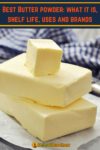
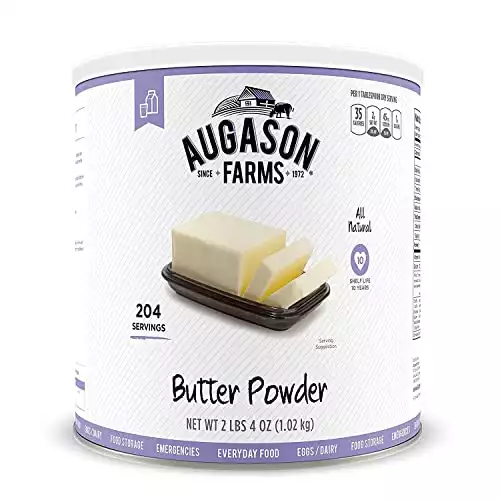
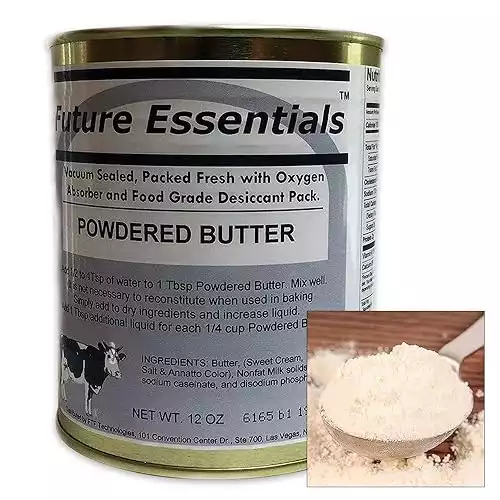
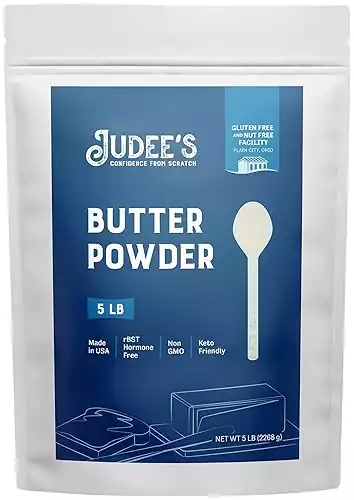
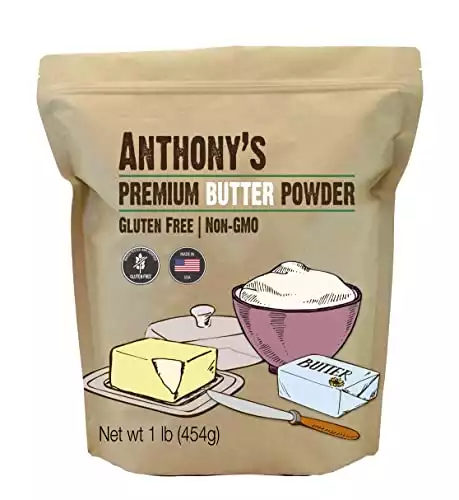
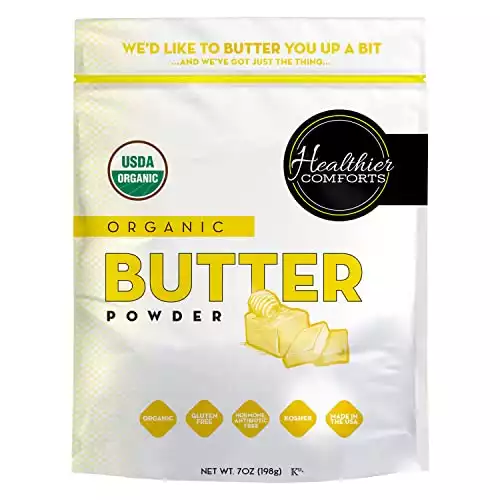
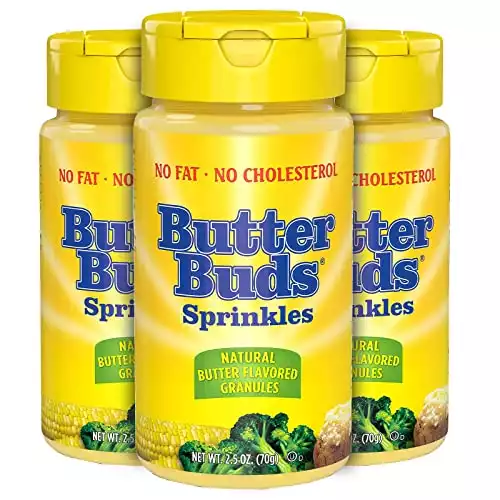


Ghee’s another alternative to butter powder. Good shelf life.